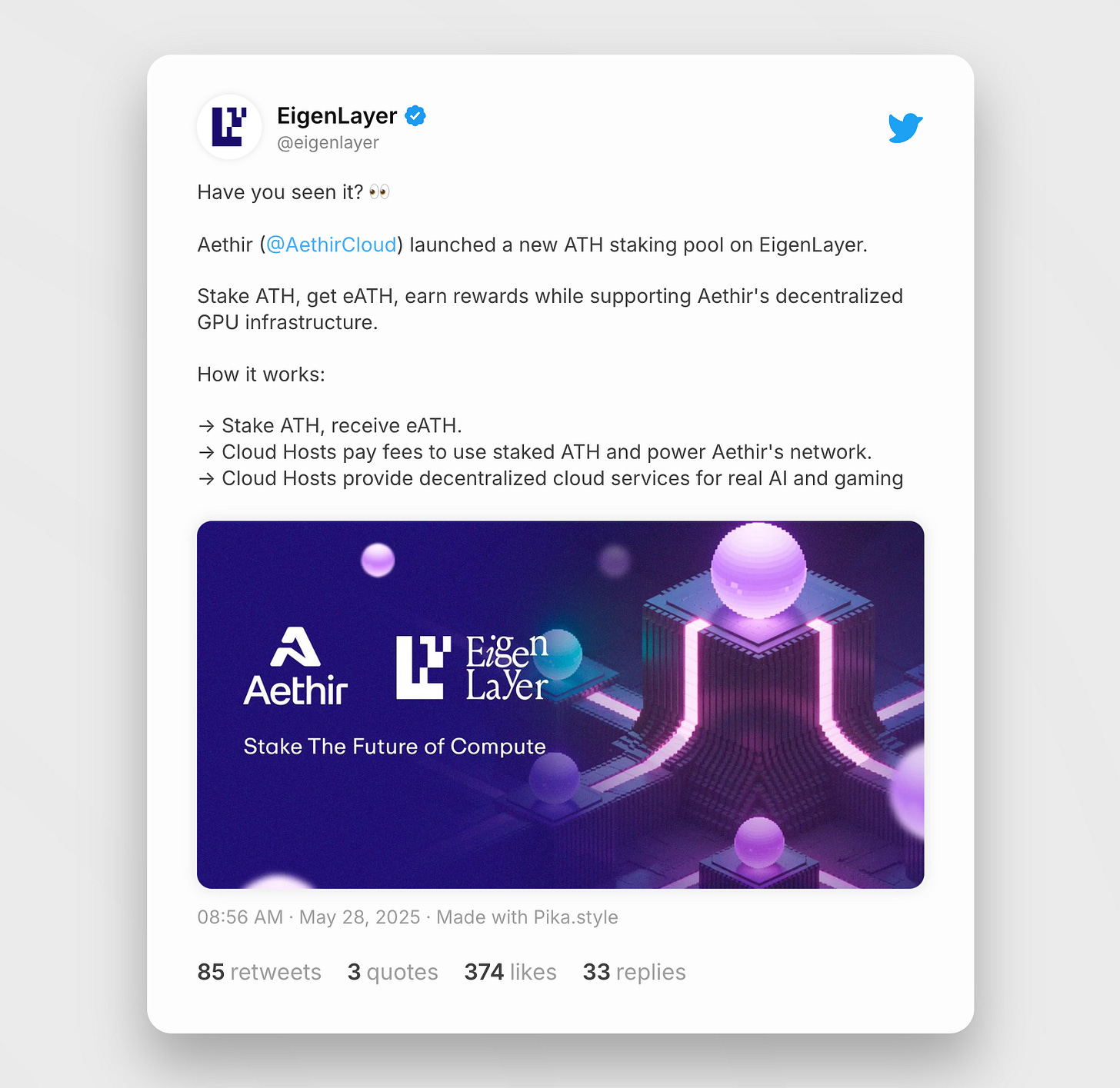Re:Staking Weekly #29
Restaking as Insurance, ZK Super Aggregator, Karak's Public Testnet, and Aethir's 30% APY
Welcome to Issue #29 of Re:Staking Weekly! 👋
This week, we're revisiting the theme of value redistribution, exploring how insurance has suddenly emerged as a promising vertical in the restaking ecosystem. What once felt abstract now hints at a wave of consumer-facing DeFi applications built directly on top of restaking infrastructure. For capital allocators, this opens the door to more compelling APRs and diversified exposure. We're excited by this unexpected new avenue that restaking has stumbled upon.
Also in this issue:
Podcast with Fermah’s Vanishree on the ZK proof super-aggregator
Karak launches its public testnet
Aethir’s EigenLayer-backed ATH staking with up to 30% APY
Fuel Network integrates EigenDA as its default DA layer
… and more
Let’s dive in! 🚀
Restaking as Insurance
During the 2021 bull market, decentralized insurance protocols emerged across DeFi, aiming to bring traditional insurance models on-chain and protect against the rising threat of protocol exploits. But nearly all of them failed.
Now, a new signal is taking shape in the restaking space. Restaking, originally designed to secure off-chain verifiable services through economic guarantees on decentralized operators, is unexpectedly expanding into a broader role. Restaked capital is now being used to underwrite the financial risks of protocols directly, effectively functioning as insurance. It is a use case that even EigenLayer founder Sreeram has acknowledged he did not originally foresee.
Simultaneously, other restaking protocols and industry thought leaders are beginning to highlight this emerging opportunity:
SatLayer’s founder called insurance one of the most promising use cases for restaked BTC.
Sreeram, founder of EigenLayer, emphasized how restaking’s redistribution mechanisms expand its scope, allowing restaked capital to underwrite generalized financial risks.
Praneeth (Ethereal VC) and Jim Parillo (Figment Capital) both highlighted this as a broad and actively sought-after use case, noting that projects are already raising capital around it.
Why Restaking as Insurance Could Work
Restaking addresses several fundamental issues that led to the failure of earlier DeFi insurance protocols:
1. Objective Slashing and Redistribution Terms
Unlike traditional DeFi insurance, where coverage terms were often vague and reliant on subjective governance votes, restaking enables protocols to define clear, enforceable slashing and redistribution conditions. The insured project sets the rules up front, making risk outcomes deterministic and programmable.
2. Abundant Idle Capital Seeking Yield
Restaking already concentrated billions in idle staked assets. Insurance is a natural extension of this capital, offering yield without needing to actively market it.
3. Neutral Infrastructure, Not a Middleman
Restaking protocols serve as neutral coordination layers. They allow capital providers and insured protocols to engage directly, setting their own terms and pricing risk transparently. This removes the need for insurance-specific intermediaries, and instead creates a dynamic marketplace for trust and coverage.
Conclusion
The most interesting takeaway from this emerging signal is not just the insurance use case itself, which still needs time to play out. What stands out more is what it reveals about restaking as a platform.
First, the modularity of restaking, combined with the abundance of idle capital, creates a large, open design space. This allows market participants to invent new and unexpected applications beyond the original intent.
Second, many of these emerging use cases are no longer infrastructure or middleware, but user-facing applications. These types of projects typically ramp up faster and have more direct control over reward flows to capital providers, compared to slower-moving middleware layers.
As Cap Protocol launches its product and leveraging restaking as insurance, we should see more similar experiments popping up soon.
The ZK Super Aggregator
In this episode, we had the chance to speak with Vanishree Rao, founder of Ferma, and dive deep into why, despite the rapid acceleration of ZK adoption, the infrastructure for proof generation remains fragmented, expensive, and difficult to scale. Ferma addresses this gap by serving as a neutral coordination layer between proof seekers, such as zkRollups, and provers operating GPU infrastructure. The platform offers a modular system that handles everything from pricing and matchmaking to workflow orchestration and performance optimization, making proof generation seamless and scalable for developers.
Learn More
Protocol News
Latest updates on restaking protocol developments across the Ethereum, Bitcoin, and Solana ecosystems
EigenLayer’s Hoodi Testnet is now live, enabling broader and more stable protocol testing across the ecosystem.
SatLayer just kicked off a new restaking points campaign.
OKX Wallet now supports direct BTC restaking to Babylon.
Karak, the Ethereum-based alternative to EigenLayer and Symbiotic, is preparing to launch its inaugural public testnet.
AVS & Restaking Ecosystem
News on the latest AVS partnerships, feature releases, and innovations in the restaking ecosystem
Aethir’s EigenLayer-backed ATH staking campaign is now live. Restakers can earn up to 30% APY in fees from cloud hosts.
Hyperland and Eclipse have teamed up to launch tUSD, a crosschain-native stablecoin with built-in yield.
Fuel Network is transitioning from Ethereum DA to EigenDA as its default data availability provider.
That's it for this week's newsletter! As always, feel free to send us a DM or comment directly below with your thoughts or questions.
If you want to catch up with the latest news in the restaking world, give our curated X list a follow!
See you next week and thanks for reading,












